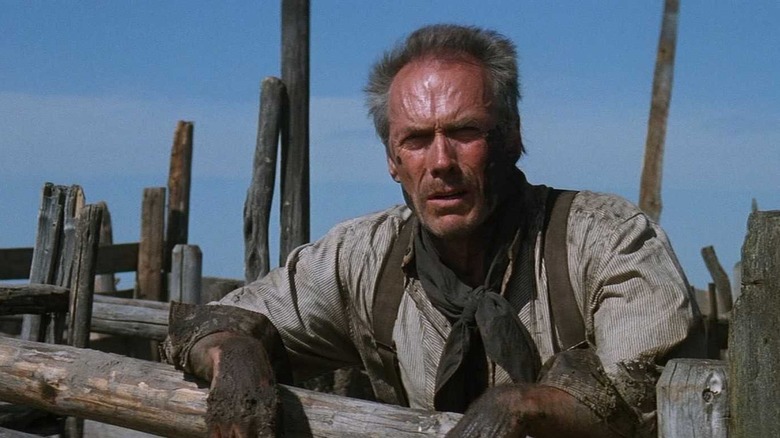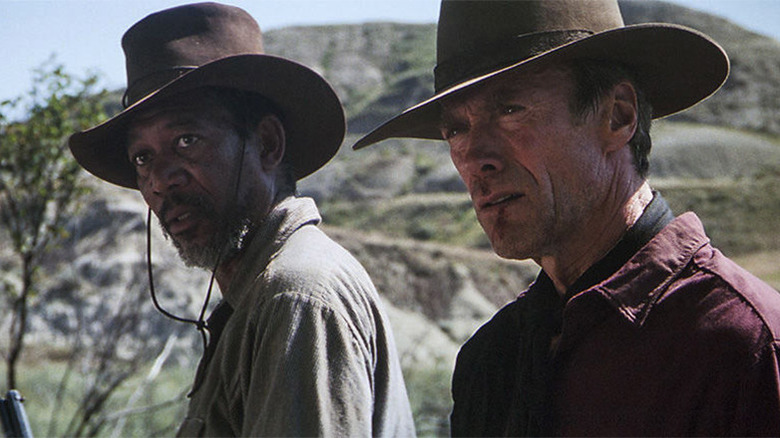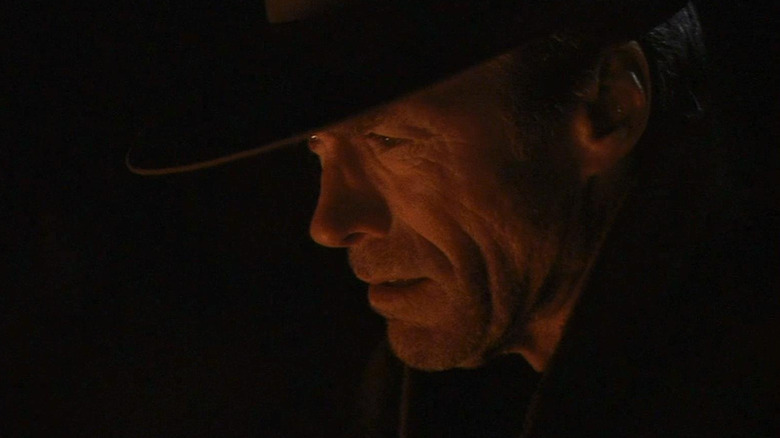Unforgiven Borrowed A Visual Trick From The Era Of Black And White Films
Clint Eastwood's first credit came in the 1955 film "Revenge of the Creature," a sequel to "Creature from the Black Lagoon" in which he played a lab technician. Thirty-seven years later, in 1992, Eastwood had amassed over a hundred acting credits, having gained a reputation for playing gunslingers, cowboys, and a wide variety of grizzled tough guys. By 1992, he had also directed 16 notable films. For Eastwood, "Unforgiven" represented a change in his mission statement as a filmmaker. "Unforgiven" is about a former gunslinger who is trying to live humbly after a long life of violence and murder. He will be pulled back into action when hired to enact revenge on a group of evil cowboys who assaulted a group of sex workers.
"Unforgiven" is a bleak film that seeks to follow an archetypal gunslinger character to their logical end: A life full of gunfire and killing will, Eastwood posits, damage the soul beyond repair. As previously talked about in the pages of /Film, "Unforgiven" was the end of an era. Eastwood's cowboy days were behind him.
That was 30 years ago, and Eastwood, has continued to make variants of the "Don't let your babies grow up to be cowboys" story ever since. Case in point: His 2021 film "Cry Macho," which Eastwood made at age 90, was about a retired rodeo worker who has to trek into Mexico to retrieve a potentially kidnapped 13-year-old and, in so doing, teach the kid that machismo is more about nobility than toughness. Eastwood has been tearing down the myth of the American West almost as long as he spent building it up.
But let us look to "Unforgiven," the pivot point in Eastwood's career, and one the of the most awarded — and most visually gorgeous — he ever made.
Jack N. Green
The cinematographer on "Unforgiven" was Jack N. Green who had previously worked with Eastwood on "Heartbreak Ridge," "Bird," "White Hunter, Black Heart," and "The Rookie." Eastwood, being such a prolific filmmaker, has worked with multiple talented cinematographers in his directorial career, and a look over his filmography as a whole reveals a gradual visual shift. Eastwood's earlier movies tend to be more sharply photographed, with clear, bold earth tones. His later films often feature a softly focused, steelier, washed-out aesthetic. "Unforgiven" is perhaps more of the former camp, but marks the beginning of that visual shift.
In a 1992 interview with Cahiers du Cinéma (reprinted in Cinephilia & Beyond), Eastwood acknowledged that, while making a period piece, one might find a natural impulse toward using natural light; a sheen of Hollywood artificiality can be more palatable. He also talked about working with Green to achieve a hazier, more overcast look for "Unforgiven." Eastwood recalled:
"There are some of my films that I conceive more as brightly lit films, and so you have the lighting I asked Jack for in 'White Hunter, Black Heart,' which isn't a particularly dark film. 'Unforgiven' is quite simply a 'stormy' film ... What you have to remember is that it takes place at a time when people didn't have much to use for lighting, and the only artificial light came from oil lamps. So if in shooting a night scene we had decided to flood the action with light, people would have done right to ask us where all that light was coming from."
While "Unforgiven" is not literally stormy, with mostly clear skies throughout, anyone who has seen it can understand the "darker" comment about the quality of the light in the film.
Like shooting in black and white
The Cahiers interviewer compared "Unforgiven" to, of all things, the 1946 John Ford western "My Darling Clementine." That film is one of many about Wyatt Earp (Henry Fonda) and the Gunfight at the O.K. Corral. Victor Mature plays "Doc" Holliday and Tim Holt from "The Treasure of the Sierra Madre" appears as Virgil. That film, shot in black and white by Joseph MacDonald ("How to Marry a Millionaire").
Eastwood admits that he may have internalized the cinematography from "Clementine," particularly when it came to night scenes. A camera will not be able to capture low light as well as a human eye, so a good photographer will need to choose the exact level of visibility required for a scene, carefully calibrating lights and lenses to keep things dim, but still keep things visible. A "natural" night scene would hardly be visible at all. Eastwood said:
"...I'm not sure that 'Unforgiven' is much like 'My Darling Clementine,' I know what you're trying to say. Ford's picture has a number of nocturnal scenes, all right. Maybe I was unconsciously motivated by an idea close to Ford's. I tried to light my film — or rather I asked Jack Green to light it — like a black and white film. The costumes and the scenery were likewise conceived as a function of this particular lighting scheme, like one in black and white."
It seems that Eastwood, more than anything, wanted a pleasing visual uniformity to "Unforgiven," making for a great deal of photographic clarity.
Green was nominated for an Academy Award for "Unforgiven," but lost to Philippe Rousselot for "A River Runs Through It." He won an ACS Lifetime Achievement award in 2009.


